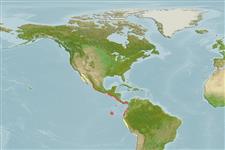Elasmobranquios (tiburones y rayas) (sharks and rays) >
Carcharhiniformes (Ground sharks) >
Sphyrnidae (Hammerhead, bonnethead, or scoophead sharks)
Etymology: Sphyrna: Probable misspelling of sphyra (Gr.), hammer, referring to their hammer-shaped heads (See ETYFish); corona: Latin for crown or halo, allusion not explained, probably referring to irregularly oval oculonarial expanse (See ETYFish).
Environment: milieu / climate zone / depth range / distribution range
Ecología
marino demersal; rango de profundidad 0 - 100 m (Ref. 121788). Tropical; 32°N - 19°S, 115°W - 69°W
Eastern Pacific: southern Mexico to northern Peru, probably including the Gulf of California.
Tamaño / Peso / Age
Maturity: Lm ? range ? - ? cm
Max length : 92.0 cm TL macho / no sexado; (Ref. 244)
Found on the continental shelf, presumably inshore. Viviparous, presumably with 2 young per litter. Probably the smallest species of hammerhead.
Life cycle and mating behavior
Madurez | Reproducción | Puesta | Huevos | Fecundidad | Larva
Viviparous, placental (Ref. 50449).
Compagno, L.J.V., 1984. FAO Species Catalogue. Vol. 4. Sharks of the world. An annotated and illustrated catalogue of shark species known to date. Part 2 - Carcharhiniformes. FAO Fish. Synop. 125(4/2):251-655. Rome: FAO. (Ref. 244)
IUCN Red List Status (Ref. 130435: Version 2024-1)
Threat to humans
Harmless
Human uses
Pesquerías: pesquerías de subsistencia
Herramientas
Special reports
Download XML
Fuentes de Internet
